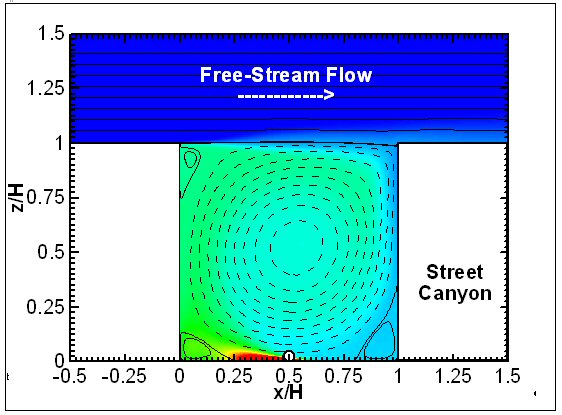Most of the vehicular emissions are chemically reactive, e.g. nitrogen oxides, hydrocarbons, and carbon monoxide. Photochemical processes lead to the formation of secondary pollutants which are often more harmful than the primary ones, e.g. ozone. The situation is worst when the timescales of chemical reactions and turbulent removal of pollutants are of comparable magnitudes.
As pollutants are not well-mixed in street canyons, this study aims to investigate the physical and chemical processes of pollutants in street canyons numerically. The main scientific challenges are the complex and closely correlated physical and chemical behaviors of pollutants which are hardly to be measured experimentally to good accuracy. Besides, the broad range of spatio-temporal scales poses extra technical difficulties on the numerical models. We are developing an interdisciplinary numerical model using large-eddy simulation (LES), which brings together two non-linear and chaotic sciences, and are working toward a better understanding of the physical and chemical processes of pollutants in urban street canyons.
¡@
i. the physical processes, which include turbulent pollutant mixing, transport, and removal; and
ii. the chemical processes
of vehicular pollutants in street canyons.
• Insight into the correlations between physical and chemical processes of vehicular pollutants.
• A comprehensive database that helps develop guidelines for urban planning and engineering reference.
¡@
• Liu, C.-H. and Leung, D. Y. C. (2001), ¡§Development of a Finite Element Solution for the Unsteady Navier-Stokes Equations using Projection Method and fractional-á-scheme¡¨, Computer Methods in Applied Mechanics and Engineering 190, 4301-4317.
• Liu, C.-H. and Leung, D. Y. C. (2001), ¡§Turbulence and Dispersion Studies Using a Three-Dimensional Second-Order Closure Eulerian Model¡¨, Journal of Applied Meteorology 40, 92-113.
• Liu, C.-H. and Leung, D. Y. C. (1998), ¡§Parallel Computation of Atmospheric Pollutant Dispersion Under Unstably Stratified Atmosphere¡¨, International Journal for Numerical Methods in Fluids 26, 677-696.
Conference Proceedings
• Liu, C.-H., Barth, M. C., and Leung, D. Y. C. (2004), ¡§Air and Gaseous Pollutant Exchange in Street Canyons of Different Building Height to Street Width Ratios¡¨, Twelfth International Conference on Modelling, Monitoring and Management of Air Pollution, June 30 to July 2, 2004, Rhodes, Greece.
Works in Progress
• Liu, C.-H., Barth, M. C., and Leung, D. Y. C. (2003), ¡§Large-Eddy Simulation of Flow and Pollutant Transport in Street Canyons of Different Building Height to Street Width Ratios¡¨, manuscript submitted to Journal of Applied Meteorology.
• Liu, C.-H., Leung, D. Y. C., and Barth, M. C. (2003), ¡§On the Prediction of Air and Pollutant Exchanges Rates in Street Canyons of Different Aspect Ratios Using Large-Eddy Simulation¡¨, manuscript submitted to Atmospheric Environment.
• Liu, C. H., Leung, D. Y. C., and Woo, C. M. (2004), ¡§Parallel Finite Element Solution to the Direct Numerical Simulation of Fluid Turbulence¡¨, in preparation.
¡@

Figure
1.
Spatial distribution of streamfunction (contour lines) and pollutant emitted
from vehicles aligned as a ground-level continuous line source (represented
by the circle) placed parallel to the street axis in an idealized street
canyon. Negative streamfunction (dashed contour lines) represents
clockwise-rotating recirculation and vice versa. The free-stream wind flow
over the street canyon is toward the right-hand-side (Liu, Barth, and Leung
2003).